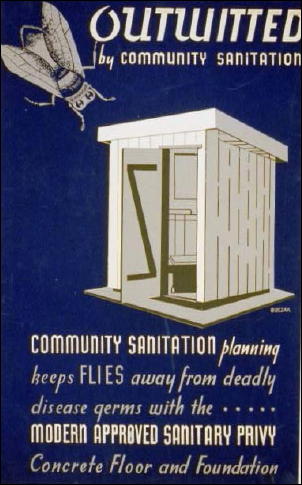
THE WPA OUTHOUSE
By Don Norman 2005
Of all the buildings on any Gilmer County WV homestead, the
outhouse was probably foremost in people's thoughts, but rarely
mentioned aloud.
This was the building you located as soon as
possible when you came to visit and if your guest was the
preacher, you invited him outside on some pretext so he could
spot "the necessary room" without asking.
The earliest central West Virginia outhouse was any handy
screen of bushes, a club to beat off the wolves and an attentive
eye for poison ivy, nettles and yellow jacket nests. Life was
simpler then. Multiflora rose was unknown.
By 1930, outhouse construction had progressed and the
typical edifice provided a place to sit, protection from the
rain, a fair degree of privacy.
A typical building was sited on the bank of a watercourse
with the rear elevated so that rising waters would sweep away
deposited wastes.
Frequently, the rear of such buildings faced a
public or semi-public roadway, allowing passers to throw flaming paper or grass
or firecrackers underneath if they felt the occupant needed a
little excitement or inspiration.
Sometime around 1900, medical scientists connected the
annual typhoid fever outbreaks with the use of water polluted
with human waste.
Prior to this discovery, it was believed water
polluted with human waste was purified when the materials were no
longer visible to the naked eye.
The microbes visible with a
microscope were regarded as interesting and even amusing, but too
small to be worthy of notice.
When the connection between polluted water and typhoid was
firmly established, the medical profession swung into action to
reduce the incidence of this disease.
Typhoid would go through an
entire family and leave the survivors too debilitated to earn
enough to pay their doctor in a reasonable time.
By the mid nineteen thirties, cities had begun processing
their sewage, municipal water supplies had been improved and the
time had come to improve rural sanitation.
Because this was in
the midst of the great Depression,people were out of work and
destitute, and because most politicians lived downstream from
rural people, the federally funded Works Progress Administration
(WPA) built thousands of outhouses in central West Virginia
according to a basic design developed by the American Red Cross.
This design featured an enclosed, vented pit for the waste, was
fly and vermin proof and afforded a standard of cleanliness and
sanitation that earlier generations would have considered effete.
The building had a concrete floor and a carefully
carpentered seat with a close fitting lid to exclude flies.
Although many design variations have been noted, the two basic
designs were single seater and two seater.
The two seater was preferred by large families, with a
smaller hole in the second seat to prevent children from falling
through, by those who liked company and those who needed a place
to set their lantern at night.
In the late 1930's, one country wit who was disillusioned
with both the Democratic and Republican political parties
maintained that Democrats preferred two holers and Republican
used single seat facilities.
His reasoning was that Democrats
couldn't do anything without a consultant and Republicans were
usually constipated.
The crescent shaped vent or peephole in the door beloved by
a generation of cartoonists was not a feature of these WPA
edifices, possibly because photographs might appear in newspapers
in Muslim countries, where the crescent has the same religious
significance that the cross has in Christian societies.
The concrete floor for these buildings was pre-cast and then
moved over the pit and the building constructed. This gave the
owner of the edifice a choice as to the number of seats and their
arrangement.
One source tells of a resident specifying a space
between the seats large enough to accommodate a galvanized wash
tub, so that the owners could bathe in the outhouse.
One typical WPA outhouse construction crew consisted of Park
Norman, Melville Brady and Ray T. Cottrill. Their headquarters
was on Lloyd Yoak's property on Tanner's Fork of Steer Creek,
near the old Shock schoolhouse.
Ray was in charge of site
preparation, (he dug the pit) while Park and "Mel" pre-cast the
floors and prefabricated the buildings in sections.
Once the pit was dug, the floor and sections of the building
were hauled to the site on a Model A Ford truck and erected.
Although all the members of this crew went on to bigger things,
they played an important part in controlling a serious and
dangerous disease.
The universal joke of a Sears catalog in the outhouse bore
more truth than fiction in the Depression years. Usually, the
Spring and Summer catalog was relegated to the outhouse on the
very day the Fall and Winter catalog was delivered.
More than a
few families split their mail order business between Sears and
Montgomery Ward for the sole advantage of having a better supply
of toilet paper.
Both these companies issued catalogs that had
indexes of thin, soft paper, and that index was first to go.
Things got rather unpleasant just before the new catalog came and
only the slick, colored pages were left in the old outhouse.
An example of this humor is found in the weekly newspaper
report of an outhouse fire within the paper's distribution area.
The paper reported that the edifice was totally destroyed and it
was believed that the fire started when a candle being used for
illumination ignited the catalog.
What a stirring event the dedication of the first WPA
outhouse must have been!
The mind boggles at the bands that must
have been playing, the dedication speeches, the president of
Sears appearing to affix the catalog and the backbiting and
politicking that must have occurred for the honor of tearing off
the first sheet. - Don Norman is a well-known Gilmer County historian and genealogist
Visit Don Ponders Outhouse Tour www.donponder.com
| 


